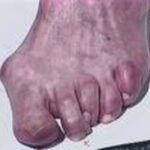My initial reaction to the tidal of wave of excitement over the trendy, minimalist toe shoes was skepticism, reminiscent of the booty blaster shoe craze several years back. (Remember how Skechers Shape-Ups shoes stumbled when the American Council of Exercise showed zero evidence of any improvement in tone, muscle strengthening, or increased calorie burning? Or how Reebok entered into a twenty-five million dollar settlement with consumers over false advertisement of their Easy Tone sneakers?)
As a professional physical therapist, having an informed, fact-based opinion on new types of performance footwear is especially critical; my opinion can have a significant impact on the patients I advise. So when my clients started asking about the freaky looking footwear, before offering an endorsement or caveat to my patients, research was in order.
At the 9th Annual Current Concepts of Primary Sports Medicine Conference, I was confident I would find answers. All those sports medicine specialists and orthopedists must know if these shoes are fantastic or a fad. Unfortunately, all of the specialists I consulted gave answers that sounded like politicians during an election year; no one was willing to go on the record with a final opinion, pro or con. The one universal take-away I had was that until there was hard scientific, clinical research, no one was going to commit.
From a physical therapist’s standpoint, when it comes to shoes, it’s all about performance in terms of whether or not they are helpful or harmful. Or, in the case of toe shoes, simply embarrassing with no tangible benefit.
In the absence of double-blind studies in peer-reviewed journals, I looked to my own knowledge and experience to form an opinion. (Because if you’re going to walk around in shoes that give you toe wedgies, you better be able to justify it.)
Runners have two primary concerns when it comes to footwear: performance enhancement and injury prevention. So to determine the merits of toe shoes while we wait for the years of research to complete, that’s where I began.
When dealing with running injuries, most ailments generally stem from the impact of the foot contacting the ground and then transferring up the lower leg. Bare feet have sensory feedback that provides the brain with information, such as, “I’m walking on an uneven path. I should be careful.” But even more importantly, there is evidence demonstrating that while running barefoot, the arch cushions the impact due to the body’s ability to adjust the stiffness of the leg in reaction to foot stimuli regarding the running surface. Further, there is other research that indicates that running with a traditional, cushioned shoe inhibits sensory feedback, and can lead to higher impact forces in the leg. And, the protective soles and motion inhibiting barriers of traditional running shoes can amplify foot weakness, leaving a runner with a susceptibility to plantar fasciitis (arch pain) and even stress fractures in the tibia bone in the lower leg.[1] This communication between foot and brain is the reason for so many barefoot running enthusiasts. That said, you can also find research from the shoe manufacturers that assert that some types of running gaits (especially those of runners who hit the ground heel first instead of forefoot first), lessen the impact with a properly cushioned shoe.
Still, I believe the potential benefits of barefoot running, especially for runners who are concerned about stress injuries, should be seriously investigated. Intuitively, there are issues with running barefoot (in addition to no service, especially in conjunction with no shirt), hence the interest in toe shoes. Because whether you’re a runner who takes the city streets or the most pristine path, sharp objects are always a concern. In summer, unless you practice firewalking, burns from hot pavement may also be an issue. Which brings about the new popularity of toe shoes-all the (theoretical) benefits of barefoot running without the tetanus.
As an occasional 5K runner, I decided to become my own guinea pig and try out the toe shoe. Personally, I discovered I was more aware of my gait while running and that we have to give our body credit on how it adapts to environmental stresses and obstacles thrown its way.
My professional opinion of the toe shoe is that it is definitely worth a try-in moderation. With the evidence suggesting toe shoes can alleviate or even prevent certain types of injury, they are certainly worth a trial. As always, approach anything new when it comes to running or any other type of workout, in moderation. If you have existing foot pain or minimal to severe deformities in the foot that require support, consult your physical therapist before trying a new type of footwear.
Of course, be certain to ensure the shoes are comfortable and fit properly. Try them on for one hour the first day while performing regular activities, before you try running, and then progress the longevity in the shoes conservatively, to let your body adapt to the new stresses. Make note of how your foot consistently contacts the ground. Do not drastically change your gait. If you have no pain that means it’s safe to progress. Pain during or afterward is a red flag you progressed too quickly, or it might not be the right footwear for you. Of course, consult your physical therapist immediately if any pain occurs or persists.
What do you think about the toe shoes? Have you tried them? If so, what do you think?
[1] William, J. 2010. Nature. Barefoot Running Strikes Back, 463


